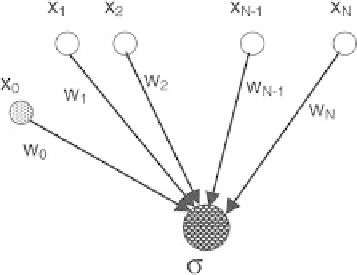Information Technology Reference
In-Depth Information
Fig. 6.3.
Schematic diagram of a perceptron
One element of choice between those approaches is the actual implementa-
tion of the application. Estimating probabilities on a digital computer is not
a problem. If the classifier will be implemented on a special-purpose device,
binary units can considerably improve the computation times and the com-
plexity of the circuits. A comparison between neural networks using binary
and real-valued neurons on an application of radar signals recognition may be
found in the Ph.D. thesis of Christelle Godin [Godin 2000].
6.2 Linear Separation: The Perceptron
The simplest network allowing the classification of data into two classes is a
single binary neuron. Introduced by Rosenblatt [Rosenblatt 1958], who called
it perceptron, it is shown schematically on Fig. 6.3. The output of Rosenblatt's
perceptron depends on the weighted sum of the input vector components
x
i
,
with weights
w
i
∈
R
. This weighted sum, hereinafter called potential (as
in the previous chapters), is called field in the articles written by physicists
that studied the properties of neural networks. A Perceptron shares many
properties with the
spins
, which are elementary magnets. In particular, the
weighted sum plays the same role as the magnetic field in the context of the
physicists' models of magnetism.
Since the potential is a linear function of the inputs, the perceptron is
also called linear classifier. However, as already mentioned in Chap. 1, we
will consider generalized non-linear potentials, like polynomials (higher-order
neurons).
If the perceptron potential is larger than the neuron threshold
s
0
,theout-
put is
σ
= +1, otherwise
σ
=
1. Thus, the perceptron is a neuron whose
activation function is a threshold function. In Fig. 6.3 we followed the conven-
tion used in the previous chapters, and we included a constant input
x
0
=1
with a weight
w
0
. Its role is to shift the threshold of the activation function.
Now the input has an additional component
x
0
= 1, so that we consider a
−

Search WWH ::

Custom Search